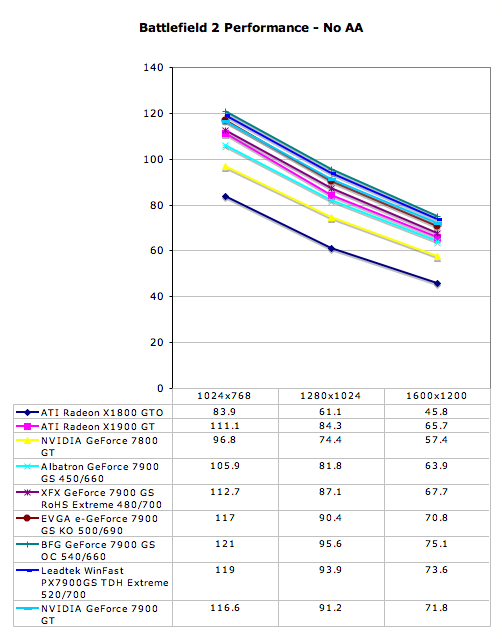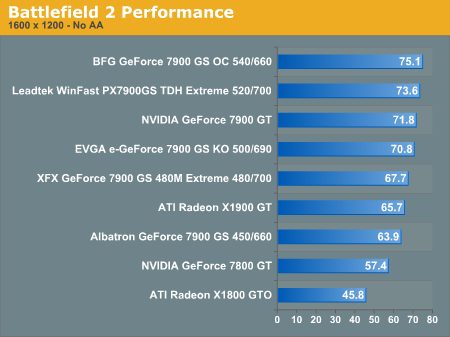The NVIDIA GeForce 7900 GS: A Closer Look
by Josh Venning on September 19, 2006 5:00 AM EST- Posted in
- GPUs
Test Setup
We already had a look at how the 7900 GS performs relative to several other cards currently on the market from both ATI and NVIDIA. Today we will be looking at how well these individual 7900 GSs perform relative to each other, and we've thrown in a couple of other cards from NVIDIA and ATI for reference. From NVIDIA, we included the reference 7800 GT and the 7900 GT, and from ATI, the X1900 GT and the X1800 GTO.
We tested three different games at three different resolutions to give us a general idea of performance. The games we tested were Battlefield 2, Half-Life2:Episode One, and The Elder Scrolls IV: Oblivion. We tested each of these games at 1024x768, 1280x1024, and 1600x1200 with graphics quality settings on high in each game whenever possible.
This is the system we used for testing:
*Note that sound was disabled for testing.
Battlefield 2
We start our performance tests by looking at Battlefield 2, one of our standard game benchmarks. This benchmark is basically a running game demo following several players in different vehicles (including a jet) and on foot in third-person view. This gives us samples from different perspectives in the game and provides a good overview of the performance in Battlefield 2. Detail settings are on "High" for testing.


The five 7900 GS samples we have here offer a good representation of the performance potential this card has with different factory overclocks from card manufacturers. The "out of the box" performance of the 7900 GS will vary more or less depending on the game between different card versions. In Battlefield2, we see a significant difference between performance between the slowest 7900 GS (the Albatron GeForce 7900 GS) which is clocked at reference speeds, and the higher clocked BFG GeForce 7900 GS OC. At 1600x1200 resolution, there is a 17.5% framerate increase with the overclocked BFG 7900 GS, which could definitely be a noticeable improvement during gameplay.
Also, we can see how at reference speeds, the 7900 GS gets lower framerates than the reference 7900 GT, but most of our factory overclocked 7900 GS cards match or surpass the performance of the 7900 GT in each resolution. This is important considering that the 7900 GT generally costs around $100 more than the 7900 GS. Keep in mind however, that the 7900 GT has potential for overclocking as well, and its performance potential will exceed that of the 7900 GS depending on the specific card and application.
Something else we see that is particularly noteworthy here and in the other game tests is how ATI's X1900 GT compares to these 7900 GS cards in performance. The 7900 GS at reference speeds doesn't perform as well as the X1900 GT; for example, at 1024x768 the Albatron 7900 GS gets a framerate of 105.9 FPS verses the X1900 GT's 111.1 FPS. But as we saw in the previous example, our Leadtek and BFG 7900 GS samples get higher performance with their factory overclocks, which is of interest given these cards are in direct competition with each other.
We already had a look at how the 7900 GS performs relative to several other cards currently on the market from both ATI and NVIDIA. Today we will be looking at how well these individual 7900 GSs perform relative to each other, and we've thrown in a couple of other cards from NVIDIA and ATI for reference. From NVIDIA, we included the reference 7800 GT and the 7900 GT, and from ATI, the X1900 GT and the X1800 GTO.
We tested three different games at three different resolutions to give us a general idea of performance. The games we tested were Battlefield 2, Half-Life2:Episode One, and The Elder Scrolls IV: Oblivion. We tested each of these games at 1024x768, 1280x1024, and 1600x1200 with graphics quality settings on high in each game whenever possible.
This is the system we used for testing:
| CPU: | Intel Core 2 Extreme X6800 (2.93GHz/4MB) |
| Motherboard: | Intel D975XBX (LGA-775) ASUS P5NSLI |
| Chipset: | Intel 975X NVIDIA nForce 570 SLI |
| Chipset Drivers: | Intel 7.2.2.1007 (Intel) NVIDIA nForce 8.22 |
| Hard Disk: | Seagate 7200.7 160GB SATA |
| Memory: | Corsair XMS2 DDR2-800 4-4-4-12 (1GB x 2) |
| Video Card: | Various |
| Video Drivers: | ATI Catalyst 6.8 NVIDIA ForceWare 91.47 |
| Desktop Resolution: | 1920 x 1440 - 32-bit @ 60Hz |
| OS: | Windows XP Professional SP2 |
*Note that sound was disabled for testing.
Battlefield 2
We start our performance tests by looking at Battlefield 2, one of our standard game benchmarks. This benchmark is basically a running game demo following several players in different vehicles (including a jet) and on foot in third-person view. This gives us samples from different perspectives in the game and provides a good overview of the performance in Battlefield 2. Detail settings are on "High" for testing.


The five 7900 GS samples we have here offer a good representation of the performance potential this card has with different factory overclocks from card manufacturers. The "out of the box" performance of the 7900 GS will vary more or less depending on the game between different card versions. In Battlefield2, we see a significant difference between performance between the slowest 7900 GS (the Albatron GeForce 7900 GS) which is clocked at reference speeds, and the higher clocked BFG GeForce 7900 GS OC. At 1600x1200 resolution, there is a 17.5% framerate increase with the overclocked BFG 7900 GS, which could definitely be a noticeable improvement during gameplay.
Also, we can see how at reference speeds, the 7900 GS gets lower framerates than the reference 7900 GT, but most of our factory overclocked 7900 GS cards match or surpass the performance of the 7900 GT in each resolution. This is important considering that the 7900 GT generally costs around $100 more than the 7900 GS. Keep in mind however, that the 7900 GT has potential for overclocking as well, and its performance potential will exceed that of the 7900 GS depending on the specific card and application.
Something else we see that is particularly noteworthy here and in the other game tests is how ATI's X1900 GT compares to these 7900 GS cards in performance. The 7900 GS at reference speeds doesn't perform as well as the X1900 GT; for example, at 1024x768 the Albatron 7900 GS gets a framerate of 105.9 FPS verses the X1900 GT's 111.1 FPS. But as we saw in the previous example, our Leadtek and BFG 7900 GS samples get higher performance with their factory overclocks, which is of interest given these cards are in direct competition with each other.










42 Comments
View All Comments
yyrkoon - Tuesday, September 19, 2006 - link
I'd like to see how these cards compare to a 7600GT, as I currently own a eVGA 7600GT KO, and will be upgrading my current system to a conroe, and MAY consider another GFX card, especialy one this in-expencive, or maybe I'll just go the 7600GT SLI route . . .Spacecomber - Tuesday, September 19, 2006 - link
Josh probably would have done well to provide some more specific reference to the previous two Anandtech articles on the the 7900GS that Derek did, including some links to those articles, since that is where you'll find more information on how these cards compare to a wider array of video cards, including the 7600GT. However, while they tested the new 7900GS in a SLI configuration in one of those prior articles, I don't think they inclduded results from a 7600GT SLI for comparison.I'm not sure what article might have that in it for reference.
Sc4freak - Tuesday, September 19, 2006 - link
In the Oblivion test, why are do the X1800GTO and 7800GT both score 0 in the bar graph, despite their non-zero results in the line graph directly above it?Josh Venning - Tuesday, September 19, 2006 - link
Thanks for pointing this out. It's been fixed.Woodchuck2000 - Tuesday, September 19, 2006 - link
...of one of these working in SLI with a 7800GT?I'm assuming that the answer is roughly 0, but with such similar specifications, is there any hope? I've got a single 7800GT in an SLI board and can't find a second at the moment.
Re fan power consumption, you're unlikely to be looking at more than 1 watt difference across the board.
VooDooAddict - Tuesday, September 19, 2006 - link
Find someone with a 7800GT and offer them one of the 7900GS Overclocked versions in exchange.DerekWilson - Tuesday, September 19, 2006 - link
At this point, NVIDIA will not support SLI between prodcuts with different names -- even if they have the same pipeline configuration.We have mentioned that this would be quite a good incentive for people to get behind SLI, but it seems like they are worried about implying that it could work in cases where it can't.
Our suggestion is to make sli between parts that could work together an unsupported option. We haven't been able to figure out how to hack the driver to allow it, and we don't think NVIDIA will allow it.
Martrox - Tuesday, September 19, 2006 - link
Don't you think that testing these cards without any FSAA is being kind of lazy? Anyone knowledgable enough to actually read this review most likely will be using FSAA, so that kind of makes this a waste....Also, did you at least turn the drivers up to high quality?
imaheadcase - Tuesday, September 19, 2006 - link
Mmm, most people don't use FSAA. Majority of users can't tell a diffrence with it on or off.VooDooAddict - Tuesday, September 19, 2006 - link
I'd have to agree. Most people with 1280x1024 LCDs that I've met prefer to leave FSAA off (if they even mess with the setting) to get the best possible frame rates. While the max framerate might not dip below 60 ... it's the minimum framerate spike that will effect competition.I used to enjoy turning on FSAA for Everquest, but for anything more FPS competition oriented I don't know anyone who uses FSAA unless they have SLI. (Which would be why they got SLI ... to run FSAA without noticable impact to framerates.)